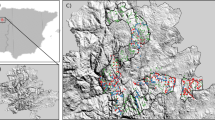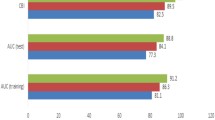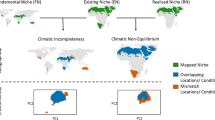Abstract
Transferability is key to many of the most novel and interesting applications of ecological niche models, such that maximizing predictive power of model transfers is crucial. Here, we explored consensus methods as a means of reducing uncertainty and improving model transferability in anticipating the potential distribution of an invasive moth (Hyphantria cunea). Individual native-range niche models were calibrated using seven modelling algorithms and four environmental datasets, representing different degrees of dimensionality, spatial correlation, and ecological relevance, and showing different degrees of climate niche expansion. Four consensus methods were used to combine individual niche models; we assessed transferability of consensus models and the individual models used to generate them. The results suggested that ideal criteria for environmental variable selection vary among algorithms, as different algorithms showed different sensitivities to spatial dimensionality and correlation. Consensus models reflected the central tendency of individual models, and reduced uncertainty by consolidating consistency across individual models, but did not outperform individual models. The question of whether interpolation accuracy comes at the expense of transferability suggests caution in planning methodologies for processing niche models to predict invasive potential. These explorations outline approaches by which to reduce uncertainty and improve niche model transferability with vital implications for ensemble forecasting.





Similar content being viewed by others
References
Ahmadzadeh F, Flecks M, Carretero MA, Böhme W, Ilgaz C, Engler JO, Harris DJ, Üzüm N, Rödder D (2013) Rapid lizard radiation lacking niche conservatism: ecological diversification within a complex landscape. J Biogeogr 40:1807–1818
Alberdi A, Aizpurua O, Aihartza J, Garin I (2014) Unveiling the factors shaping the distribution of widely distributed alpine vertebrates, using multi-scale ecological niche modelling of the bat Plecotus macrobullaris. Front Zool 11:77
Araújo MB, Whittaker RJ, Ladle RJ, Erhard M (2005) Reducing uncertainty in projections of extinction risk from climate change. Global Ecol Biogeogr 14:529–538
Araújo MB, Alagador D, Cabeza M, Nogués-Bravo D, Thuiller W (2011) Climate change threatens European conservation areas. Ecol Lett 14:484–492
Barbosa AM, Real R, Vargas JM (2009) Transferability of environmental favourability models in geographic space: the case of the Iberian desman (Galemys pyrenaicus) in Portugal and Spain. Ecol Model 220:747–754
Barry S, Elith J (2006) Error and uncertainty and habitat models. J Appl Ecol 43:413–423
Barve N, Barve V, Jiménez-Valverde A, Lira-Noriega A, Maher SP, Peterson AT, Soberón J, Villalobos F (2011) The crucial role of the accessible area in ecological niche modeling and species distribution modeling. Ecol Model 222:1810–1819
Breiman L (2001) Random forests. Mach Learn 45:5–32
Broennimann O, Guisan A (2008) Predicting current and future biological invasions: both native and invaded ranges matter. Biol Lett 4:585–589
Broennimann O, Treier UA, Müller-Schärer H, Thuiller W, Peterson AT, Guisan A (2007) Evidence of climatic niche shift during biological invasion. Ecol Lett 10:701–709
Broennimann O, Fitzpatrick MC, Pearman PB, Petitpierre B, Pellissier L, Yoccoz NG, Thuiller W, Fortin MJ, Randin C, Zimmermann NE, Graham CH, Guisan A (2012) Measuring ecological niche overlap from occurrence and spatial environmental data. Global Ecol Biogeogr 21:481–497
Buisson L, Thuiller W, Casajus N, Lek S, Grenouillet G (2010) Uncertainty in ensemble forecasting of species distribution. Global Change Biol 16:1145–1157
CABI (2015) Hyphantria cunea. Invasive species compendium. CABI Publishing, Wallingford
Choi WI, Park YS (2012) Dispersal patterns of exotic forest pests in South Korea. Insect Sci 19:535–548
Diniz-Filho JAF, Bini LM, Rangel TF, Loyola RD, Hof C, Nogués-Bravo D, Araújo MB (2009) Partitioning and mapping uncertainties in ensembles of forecasts of species turnover under climate change. Ecography 32:897–906
Elith J, Burgman MA, Regan HM (2002) Mapping epistemic uncertainties and vague concepts in predictions of species distributions. Ecol Model 157:313–329
Elith J, Phillips SJ, Hastie T, Dudík M, Chee YE, Yates CJ (2011) A statistical explanation of MaxEnt for ecologists. Divers Distrib 17:43–57
Escobar LE, Lira-Noriega A, Medina-Vogel Peterson AT (2014) Potential for spread of the white-nose fungus (Pseudogymnoascus destructans) in the Americas: use of Maxent and NicheA to assure strict model transference. Geospat Health 9:221–229
Fitzpatrick MC, Hargrove WW (2009) The projection of species distribution models and the problem of non-analog climate. Biodivers Conserv 18:2255–2261
Fitzpatrick MC, Weltzin JF, Sanders NJ, Dunn RR (2007) The biogeography of prediction error: Why does the introduced range of the fire ant over-predict its native range? Global Ecol Biogeogr 16:24–33
Gregory AW, Smith GW, Yetman J (2001) Testing for forecast consensus. J Bus Econ Stat 19:34–43
Guisan A, Tingley R, Baumgartner JB, Naujokaitis-Lewis I, Sutcliffe PR, Tulloch AIT, Regan TJ, Brotons L, McDonald-Madden E, Mantyka-Pringle C, Martin TG, Rhodes JR, Maggini R, Setterfield SA, Elith J, Schwartz MW, Wintle BA, Broennimann O, Austin M, Ferrier S, Kearney MR, Possingham HP, Buckley YM (2013) Predicting species distributions for conservation decisions. Ecol Lett 16:1424–1435
Guisan A, Petitpierre B, Broennimann O, Daehler C, Kueffer C (2014) Unifying niche shift studies: insights from biological invasions. Trends Ecol Evol 29:260–269
Harrigan RJ, Thomassen HA, Buermann W, Smith TB (2014) A continental risk assessment of West Nile virus under climate change. Glob Change Biol 20:2417–2425
Hayes KR, Barry SC (2007) Are there any consistent predictors of invasion success? Biol Invasions 10:483–506
Heikkinen RK, Luoto M, Araújo MB, Virkkala R, Thuiller W, Sykes MT (2006) Methods and uncertainties in bioclimatic envelope modelling under climate change. Prog Phys Geogr 30:751–777
Heikkinen RK, Marmion M, Luoto M (2012) Does the interpolation accuracy of species distribution models come at the expense of transferability? Ecography 35:276–288
Hernandez PA, Graham C, Master LL, Albert DL (2006) The effect of sample size and species characteristics on performance of different species distribution modelling methods. Ecography 29:773–785
Hijmans RJ, Cameron SE, Parra JL, Jones PG, Jarvis A (2005) Very high resolution interpolated climate surfaces for global land areas. Int J Climatol 25:1965–1978
Itô Y, Hattori I (1975) Status of black-headed and red-headed types of Hyphantria cunea (Drury) (Lepidoptera: Arctiidae). III. Distribution of various types and the discussion on the relationship among them. Appl Entomol Zool 10:189–202
Itô Y, Warren LO (1973) Status of black-headed and red-headed types of Hyphantria cunea (Drury) (Lepidoptera: Arctiidae). I. Biology of two types and results of crossing experiment. Appl Entomol Zool 8:157–171
Jaenike J, Selander RK (1980) On the question of host races in the fall webworm, Hyphantria cunea. Entomol Exp Appl 27:31–37
Jiménez-Valverde A, Peterson AT, Soberón J, Overton J, Aragón P, Lobo JM (2011) Use of niche models in invasive species risk assessments. Biol Invasions 13:2785–2797
Lawler JJ, White D, Neilson RP, Blaustein AR (2006) Predicting climate-induced range shifts: model differences and model reliability. Global Change Biol 12:1–17
Li XH, Wang Y (2013) Applying various algorithms for species distribution modelling. Integr Zool 8:124–135
Liu X, Li XP, Liu ZT, Tingley R, Kraus F, Guo ZW, Li YM (2014) Congener diversity, topographic heterogeneity and human-assisted dispersal predict spread rates of alien herpetofauna at a global scale. Ecol Lett 17:821–829
Loewy KJ, Flansburg AL, Grenis K, Kjeldgaard MK, Mccarty J, Montesano L, Vernick J, Murphy SM (2013) Life history traits and rearing techniques for fall webworms (Hyphantria cunea Drury) in Colorado. J Lepid Soc 67:196–205
Mahoney PJ, Beard KH, Durso AM, Tallian AG, Long AL, Kindermann RJ, Nolan NE, Kinka D, Mohn HE (2015) Introduction effort, climate matching and species traits as predictors of global establishment success in non-native reptiles. Divers Distrib 21:64–74
Marmion M, Parviainen M, Luoto M, Heikkinen RK, Thuiller W (2009) Evaluation of consensus methods in predictive species distribution modelling. Divers Distrib 15:59–69
Medley KA (2010) Niche shifts during the global invasion of the Asian tiger mosquito, Aedes albopictus Skuse (Culicidae), revealed by reciprocal distribution models. Global Ecol Biogeogr 19:122–133
Owens HL, Campbell LP, Dornak LL, Saupe EE, Barve N, Soberón J, Ingenloff K, Lira-Noriega A, Hensz CM, Myers CE, Peterson AT (2013) Constraints on interpretation of ecological niche models by limited environmental ranges on calibration areas. Ecol Model 263:10–18
Pearson RG, Thuiller W, Araújo MB, Martínez-Meyer E, Brotons L, McClean C, Miles L, Segurado P, Dawson TP, Lees DC (2006) Model-based uncertainty in species range prediction. J Biogeogr 33:1704–1711
Petersen MJ (2013) Evidence of a climatic niche shift following North American introductions of two crane flies (Diptera; genus Tipula). Biol Invasions 15:885–897
Peterson AT (2003) Predicting the geography of species’ invasions via ecological niche modeling. Q Rev Biol 78:419–433
Peterson AT, Cohoon KP (1999) Sensitivity of distributional prediction algorithms to geographic data completeness. Ecol Model 117:159–164
Peterson AT, Nakazawa Y (2008) Environmental data sets matter in ecological niche modelling: an example with Solenopsis invicta and Solenopsis richteri. Global Ecol Biogeogr 17:135–144
Peterson AT, Vieglais DA (2001) Predicting species invasions using ecological niche modeling: new approaches from bioinformatics attack a pressing problem. Bioscience 51:363–371
Peterson AT, Soberón J, Sánchez-Cordero V (1999) Conservatism of ecological niches in evolutionary time. Science 285:1265–1267
Peterson AT, Papeş M, Eaton M (2007) Transferability and model evaluation in ecological niche modeling: a comparison of GARP and Maxent. Ecography 30:550–560
Peterson AT, Papeş M, Soberón J (2008) Rethinking receiver operating characteristic analysis applications in ecological niche modeling. Ecol Model 213:63–72
Peterson AT, Soberón J, Pearson RG, Anderson RP, Martínez-Meyer E, Nakamura M, Araújo MB (2011) Ecological niches and geographic distributions. Princeton University Press, Princeton
Petitpierre B, Kueffer C, Broennimann O, Randin C, Daehler C, Guisan A (2012) Climatic niche shifts are rare among terrestrial plant invaders. Science 335:1344–1348
Phillips SJ, Anderson RP, Schapire RE (2006) Maximum entropy modelling of species geographic distributions. Ecol Model 190:231–259
Qiao HJ, Soberón J, Peterson AT (2015) No silver bullets in correlative ecological niche modelling: insights from testing among many potential algorithms for niche estimation. Methods Ecol Evol 6:1126–1136
Qiao HJ, Peterson AT, Campbell L, Soberón J, Ji LQ, Escobar L (2016) NicheA: creating virtual species and ecological niches in multivariate environmental scenarios. Ecography. doi:10.1111/ecog.01961
R Core Team (2015) R: A language and environment for statistical computing. R Foundation for Statistical Computing, Vienna, Austria. http://www.R-project.org
Soberón J, Nakamura M (2009) Niches and distributional areas: concepts, methods, and assumptions. PNAS 106:19644–19650
Stockwell D, Peters D (1999) The GARP modelling system: problems and solutions to automated spatial prediction. Int J Geogr Inf Sci 13:143–158
Strubbe D, Broennimann O, Chiron F, Matthysen E (2013) Niche conservatism in non-native birds in Europe: niche unfilling rather than niche expansion. Global Ecol Biogeogr 22:962–970
Synes NW, Osborne PE (2011) Choice of predictor variables as a source of uncertainty in continental-scale species distribution modelling under climate change. Global Ecol Biogeogr 20:904–914
Thuiller W (2003) BIOMOD—optimizing predictions of species distributions and projecting potential future shifts under global change. Global Change Biol 9:1353–1362
Thuiller W (2004) Patterns and uncertainties of species’ range shifts under climate change. Global Change Biol 10:2020–2027
Tingley R, Thompson MB, Hartley S, Chapple DG (2016) Patterns of niche filling and expansion across the invaded ranges of an Australian lizard. Ecography 39:270–280
Wang W, McKay BD, Dai C, Zhao N, Zhang R, Qu Y, Song G, Li SH, Liang W, Yang X, Pasquet E, Lei F (2013) Glacial expansion and diversification of an East Asian montane bird, the green-backed tit (Parus monticolus). J Biogeogr 40:1156–1169
Warren DL, Glor RE, Turelli M (2008) Environmental niche equivalency versus conservatism: quantitative approaches to niche evolution. Evolution 62:2868–2883
Wisz MS, Hijmans RJ, Li J, Peterson AT, Graham CH, Guisan A (2008) Effects of sample size on the performance of species distribution models. Divers Distrib 14:763–773
Yamanaka T, Tatsuki S, Shimada M (2001) Flight characteristics and dispersal patterns of Fall Webworm (Lepidoptera: Arctiidae) males. Environ Entomol 30:1150–1157
Yang ZQ, Wang XY, Wei JR, Qu HR, Qiao XR (2008) Survey of the native insect natural enemies of Hyphantria cunea (Drury) (Lepidoptera: Arctiidae) in China. Bull Entomol Res 98:293–302
Yang ZQ, Wang XY, Zhang YN (2014) Recent advances in biological control of important native and invasive forest pests in China. Biol Control 68:117–128
Zhu GP, Rédei D, Kment P, Bu WJ (2014) Effect of geographic background and equilibrium state on niche model transferability: predicting areas of invasion of Leptoglossus occidentalis. Biol Invasions 16:1069–1081
Acknowledgements
We are grateful to Prof. Paul Opler (Colorado State University) for sharing data and providing assistance with data from Butterflies and Moths of North America. This study was funded by National Natural Science Foundation of China (31401962), the program of Using Three Years to Introduce More than One Thousand High Level Talents in Tianjin (5KQM110030), Tianjin 131 Creative Talents Cultivation Project (ZX110204), and the Talent Introduction Program in Tianjin Normal University (5RL127).
Author information
Authors and Affiliations
Corresponding author
Electronic supplementary material
Below is the link to the electronic supplementary material.
Rights and permissions
About this article
Cite this article
Zhu, GP., Peterson, A.T. Do consensus models outperform individual models? Transferability evaluations of diverse modeling approaches for an invasive moth. Biol Invasions 19, 2519–2532 (2017). https://doi.org/10.1007/s10530-017-1460-y
Received:
Accepted:
Published:
Issue Date:
DOI: https://doi.org/10.1007/s10530-017-1460-y




